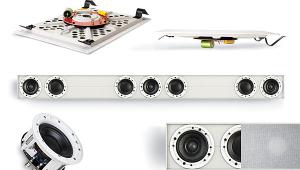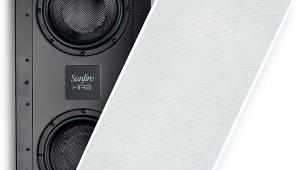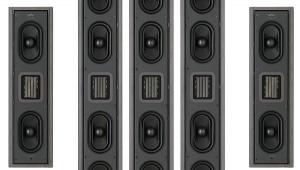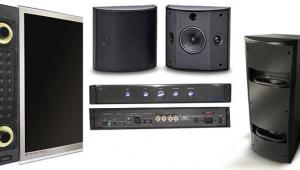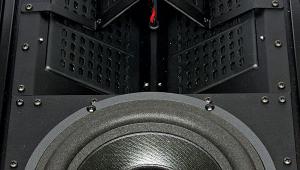Paradigm Millenia 20 Hybrid Speaker System
Thin Is the New In
If you’ve shopped for a flat-screen television lately, you know that thin is in. Flat screens that used to be 3 to 5 inches thick can hardly be called flat compared with the new models that barely exceed 1 inch in depth. And new display designs promise even thinner models in the future.

It’s only logical that manufacturers would design thin-profile speakers to go with these new ultra-thin televisions. Enter the Millenia 20 Hybrid, part of Paradigm’s Reference Series speaker line. Although in-wall speakers are almost flush with the wall, most on-wall speakers stand out farther than ultra-thin plasma or LCD HDTVs. The Millenia 20 Hybrid speaker is a cross between an in-wall and an on-wall speaker. It has the inherent performance advantages of a speaker with its own enclosure and the aesthetics to match the look and sleek profile of an ultra-thin TV. When installed, the Millenia 20 Hybrids are partially in and partially out of the wall, extending out about 1 inch, slightly more if you include the curved grille. The black frame and grille with a high-gloss black baffle neatly complement the look of an ultra-thin HDTV.
An open-back in-wall speaker can produce unpredictable results because it relies on the volume of air in the wall cavity in which it is installed. When you add wall vibrations and rattles, you have a recipe for less than ideal sound quality. The Millenia 20 Hybrids have sealed enclosures that simply recess into the wall. These enclosures offer performance advantages, particularly in the bass.
I tested the Millenia 20 Hybrid speakers with several music and movie sources to find out how well they perform. At first glance, you wonder if they have what it takes to reproduce the highly dynamic soundtracks found on Blu-ray Discs and other digital music sources, but the Millenia 20 Hybrids use the same drivers as their in-room counterparts.
My review system included three Millenia 20 Hybrid speakers, which I used in an LCR front configuration, along with two Millenia ADP surround speakers and an RVC-12SQ vibration-canceling in-wall subwoofer powered by an X-850 external Class D amplifier. I installed the RVC-12SQ subwoofer in an optional back-box enclosure.
Paradigm Driver Technology
Because of its shallow profile, the Millenia 20 Hybrid looks like it would be outfitted with ribbon or planar magnetic drivers. However, Paradigm uses conventional dynamic drivers throughout. These aren’t just off-the-shelf drivers—these components are the same as those found in Paradigm’s Reference Series speakers. They were easy to spot because (in the interest of full disclosure) I own a pair of Paradigm Reference Studio 100 floorstanding speakers.

The list of high-tech materials Paradigm uses in its speakers reads like the periodic table of elements, but I’ll try to summarize the main points without using any formulas or equations. The two 4.5-inch bass drivers at the top and bottom (or far left and right) of the baffle are mineral-filled polypropylene cones with a high stiffness-to-mass ratio. Paradigm combines these with dual-layer voice coils and houses them in die-cast frames. The drivers’ high stiffness and low mass allow the woofers to move in a more piston-like manner. Ideally, this will produce tight, well-defined bass. Likewise, the two 4.5-inch midbass drivers employ similar cone materials with strong neodymium magnets, a gold-anodized aluminum phase plug, and specially designed surrounds and spiders. The single 1-inch tweeter that nests in the center of the speaker is a satin-anodized pure aluminum dome with a treated textile suspension (Paradigm calls it S-PAL) and a die-cast aluminum chassis. Second-order filters cross over the drivers at 600 hertz and 2.2 kilohertz.
The technology in the Paradigm speakers is born out of extensive work at Paradigm’s own research and testing facility. This is where Paradigm designs, tests, and refines its speakers. In my experience with Paradigm, it pays off handsomely.
The Millenia 20 Hybrid’s clean look is complemented by Paradigm’s RVC-12SQ subwoofer. The optional back box installs in a standard residential wall with 2-by-4 studs spaced 16 inches on center. You can also install it directly in the wall without the back box. The subwoofer uses two 4-by-14-inch side-firing drivers wired in phase that face each other to cancel vibrations. The woofers have a corrugated rubber surround that’s designed for long excursion and reduced distortion.
A pair of Millenia ADP surrounds completed my 5.1-channel review system. This three-way, five-driver speaker uses a similar set of drivers. The 6-inch bass driver with dual voice coils is accompanied by two side-firing 4-inch mica-loaded polymer (MLP) midbass drivers and two 1-inch S-PAL dome tweeters, all with die-cast frames and housed in an ABS thermoplastic enclo- sure. The Millenia ADP comes in a Black or White finish.
System Installation
I installed the three Millenia 20 Hybrid speakers in temporary walls I built for testing in-wall and on-wall speakers. It’s simple to install the speakers in a residential wall. You just cut a hole using the supplied template, insert the speaker, and tighten the four screws on the front of the baffle. The Millenia Hybrid 20 secures to the wall with a pre-attached GRIP bracket on the top and bottom of the back of the speaker. The most difficult part of the installation is running the speaker wires through the walls. Typically, a custom installer runs the wire, but some homeowners take on this task by themselves.

I placed the Millenia ADP speakers on a shelf at the back of the room.
I installed the RVC-12SQ subwoofer in the optional back-box enclosure. Its vibration-canceling feature kept the enclosure virtually free of vibrations, even during heavy bass passages. You can even calibrate the subwoofer using the optional Perfect Bass Kit (PBK-1, $299). It includes a microphone, mike stand, and Windows software that equalizes the subwoofer for the listening room. You can use the PBK-1 with one to four subwoofers. The PBK-1 outputs a series of test tones, then it applies EQ to achieve the targeted frequency-response curve. Paradigm recommends that you measure five listening positions in the room. The PBK-1 uses the measurements to create a graph that shows the before and after results. The process takes about 15 minutes to complete.
Movie and Music Listening
My testing setup might be considered a steep challenge because I installed the Hybrids flanking a 100-inch video projection screen. A large screen needs a large sound image to accompany the picture. The last time I looked, there weren’t many 100-inch flat-screen televisions available. Here’s what I found.
- Log in or register to post comments



